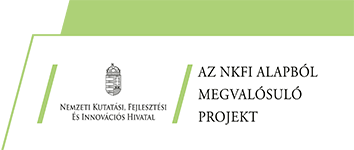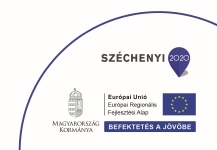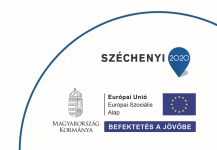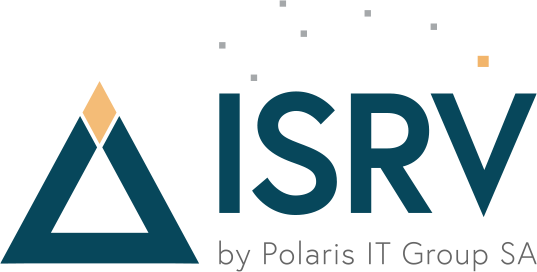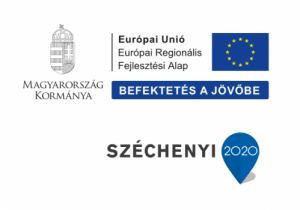
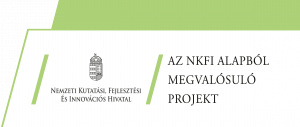
Complex implementation of innovative chip implantation technology at iSRV Zrt.
Name of beneficiary: iSRV Szolgáltató Zártkörűen Működő Részvénytársaság
Project title: Complex implementation of innovative chip implantation technology at iSRV Zrt.
Amount of aid contracted: HUF 125,223,372
Aid level (%): 70%
Project completition date: 31/03/2024.
Project ID number: GINOP_PLUSZ-1.2.3-21-2022-01941
Introduction of the project:
Our current core activities focus on innovative product development, software development, artificial intelligence (AI/MI) development, electronics and hardware development. We are currently unable to manufacture components designed and developed by our own engineers in-house. We can subcontract the production of various components. Our current main objective is to manufacture these in-house.
The installation of our own innovative chip implantation production line at our branch has a number of economic, production and manufacturing technology advantages. In-house manufacturing also makes us more economically competitive, as we can be independent from other companies, thereby reducing our manufacturing costs, lead times and exposure.
For prototyping and small batch production, which is essential to our business, manufacturing companies are less willing to accommodate our needs because the set-up of moulds is too time-consuming compared to rapid production. Because of this, these subcontracting companies either charge us high prices for these needs or we have to wait weeks to get in line.
Manufacturing involves the production of special innovative devices, where production needs change frequently. The development process may involve constant changes to the components, which are constantly evolving. If all this is outsourced to contract manufacturing, established processes have to be restarted, which means extra costs for subcontractors.
During the contract manufacturing process, 2-3 test pieces are first produced and brought to our company for testing. These are measured by our own engineers to ensure that they are of the right quality. The final production of the complete series can then be started. In-house implementation can also shorten this time, speeding up overall product development.
We also manufacture security products: encrypted data storage and communication devices. In-house production guarantees that the concept will be implemented, and that the process will not be accidentally or deliberately modified or compromised during production by a subcontractor.
In addition to our own production, we will now also be able to undertake contract manufacturing with our planned capacity. This will allow us to start a new sector, diversify our activities and generate additional revenue by serving additional customers. The planned production line could approach 100% capacity utilisation with in-house (70%) and contract manufacturing (30%) batches. There is existing market demand to serve new customers. On an annual basis, this capacity will allow the production of 50,000 parts. Various production, transport, know-how risks are also reduced by having our own production line, which also translates into money saved for our company.
We have specialists who, after retraining, will be able to operate the machinery immediately (3-4 people). The engineers are already familiar with the industry, the production technology itself, but they just need to be trained specifically for the machine.
Data-driven 3D printer and precision moulding target machine for Industry 4.0 integrity using a phase-guided radar
Name of beneficiary: iSRV Szolgáltató Zártkörűen Működő Részvénytársaság
Project title: Data-driven 3D printer and precision moulding target machine for Industry 4.0 integrity using a phase-guided radar
Amount of aid contracted: HUF 326,960,000
Aid level (%): 59,22%
Project completition date: 31.12.2024.
Project ID number: 2020-1.1.2-PIACI-KFI-2021-00327
Introduction of the project:
Data-driven 3D printer and precision moulding target machine for Industry 4.0 integrity using a phase-controlled radar
Time-unit rates that primarily influence the time to market mass-produced 3D printed products: it currently takes several days to experiment (practically guessing) what exposure time setting and brightness is required for a 3D printer and a “constantly ageing” chemical material adapted to a given workpiece and the function of the product.
The integrity of the Industry 4.0 system created in this project, including the exposure time and the amount of luminous flux required for 3D printing with SLA technology, is automatically controlled in real time by a phase-controlled radar sensor. Therefore, when 3D printing large objects with varying exposure times and varying luminous flux, competitive manufacturing reliability and time advantage that will determine the success of entering the competitive market can be ensured.
The integrity of the system created in the project is determined by the extremely high resolution and scanning speed of a domestically developed phase-guided radar sensor. Our goal is to develop an ecosystem that serves the process safety of serial production, and thus to serve a data-driven industrial integrity where the safety of meeting the downtime (maintenance) time is critical, and therefore within the development scope of the project, to create an integration for 3D printing of large objects, which can be operated at 1300 C, including a heat treatment and melting furnace and a precision vacuum casting unit to perform automated precision casting processing of 3D printed parts.
Once again, the domestically developed, high-precision phase-controlled radar array sensor plays a key role in the safe operation of complex foundry processes related to automated foundry processes based on vacuum casting following 3D printing: the process control of amorphous metal melt casting is controlled based on the radar sensor data, thus radically reducing the defect rate of inclusions (we can see in real time and with high accuracy what is happening to the liquid metal inside the mould, so we can automate the mechanical processes required for inclusion-free casting with high efficiency and data control).
Thanks to its innovative solutions, the automation of manufacturing processes requires significantly less skilled labour, making all processes and “guesswork” action patterns data-driven and Industry 4.0 compliant.
The aim of our project is to develop and build the infrastructure necessary for the mass production of the integrated target machine outlined above.
“Project 2020-1.1.2-PIACI-KFI-2021-00327 was implemented with the support of the Ministry of Innovation and Technology from the National Research Development and Innovation Fund, funded by the 2020-1.1.2-PIACI-KFI-2020 call for proposals.”
iSRV Zrt.’s innovative asset procurement
Name of beneficiary: iSRV Szolgáltató Zártkörűen Működő Részvénytársaság
Project title: iSRV Zrt. acquisition of innovative assets
Amount of aid contracted: HUF 19,697,910
Aid level (%): 69.99%
Actual project start date: 01.07.2020.
Project completion date: 31/03/2022.
Project ID number: VEKOP-1.2.6-20-2020-00686
Introduction of the project:
The primary objective of our project is to increase production through the purchase of new equipment, machinery, new technological systems and renewed capacity. The new, innovative, high-quality equipment to be acquired in the course of the project will represent a step forward for our company and will allow us to innovate.
A further objective of our project is the long-term retention of our entire workforce. This requires technological renewal, which can be achieved by purchasing specialised, modern and state-of-the-art equipment that greatly increases productivity. This will contribute to the development of the company and the overall improvement of production, as professional tools will allow us to sell higher quality products to our target group.
Zinc galvanising capacity development
Name of beneficiary: iSRV Szolgáltató Zártkörűen Működő Részvénytársaság
The original title of the project: Innovative X-ray film processing, recycling in the field of precious metal production.
Title of the project implemented: Zinc galvanising capacity development
Amount of aid contracted: HUF 381,443,300
Aid level (%): 50%
Actual completion date of the project: 31.07.2021.
Project ID number: GINOP-1.2.1-16-2017-00457
Introduction of the project:
Technical background to the project: there are several methods for coating steel and cast iron with metallic zinc, which can be used to create protective coatings with significantly different properties. The different application requirements have led to the development of coatings for surface protection (corrosion, technical) and decorative purposes. Among the metallic coatings, the most important in terms of its importance and economic potential is the technique of hot-dip galvanising in molten metal. The basic processes of coating formation are the same for all hot-dip galvanising technologies, but the duration of individual sub-processes, the method of surface pre-treatment and other characteristics may differ. As a result, the characteristic properties (texture, thickness, appearance) of the resulting coatings differ.
There are significant productivity differences between the different processes. In terms of their industrial importance, the most important hot-dip galvanising processes are batch (structural steel) and continuous plate galvanising technologies. The project will introduce the most advanced technology in the industry, offering significant business opportunities as the market continues to expand and the technology develops. The core of the technology is a special submerged centrifuge with a loading capacity of 200 kg. The material to be surface treated is immersed in a zinc-aluminium solution at a lower temperature than the molten zinc bath process, and after extraction at high speeds the solution is evenly distributed on the workpieces. The surface material distribution is caused by induced changes in the direction and angle of rotation of the centrifuge.
A major advantage of the process is that it provides high corrosion resistance for metal parts with low layer thicknesses (8-30 µm). The low temperature makes the equipment suitable for coating heat-treated parts, so springs and plates can be coated in large batches without structural damage and without human contact. A particular advantage is that the parts do not have to be individually suspended and tied to the substrate and then dismantled and cleaned at the end of the operation. The technology can also be used to achieve hydrogen-crack-free surface treatment of high-strength fasteners.
The coating system provides a cathodic protection effect, i.e. the zinc and aluminium lamellae are activated during the corrosion process and protect the base metal by forming red rust. Typical industrial applications are in the automotive industry, small fasteners, springs, fasteners, locking parts, bent and profiled sheet metal parts. The new service element that will be introduced as a result of the investment will lead to a new supplier network.
Development of a Modular Multimedia Communication Framework
Name of beneficiary: iSRV Szolgáltató Zártkörűen Működő Részvénytársaság
Project title: Development of a Modular Multimedia Communication Framework
Amount of aid contracted: HUF 690,532,454
Aid level (%): 69.98%
Actual completion date of the project: 26/09/2018.
Project ID number: GINOP-2.1.1-15-2015-00225
ISRV Zrt. (Plc) as the leader of the consortium, together with its consortium partners FINES Magyarország Kft. (Ltd.) and Intersoft Hungary Kft. (Ltd.), won a non-refundable grant under the call for proposals “Supporting R&D&I activities of companies” with their project GINOP-2.1.1-15-2015-00225 “Development of a Modular Multimedia Communication Framework”, which will be implemented jointly by the consortium members.
Aims of the project:
The development of a modular multimedia framework combining different online communication technologies (serving, live streaming, file sharing, messaging). The resulting framework will contain the functions and modules to meet the needs of services with more complex processes and will provide turnkey solutions at an affordable price for the SME sector to implement their own ideas and launch their own services.
Using this framework, a further aim is to create an online corporate training system that is as effective as traditional, face-to-face trainings. In order to achieve these goals, the project will procure a customized development environment to coordinate the work of the participating staff and suppliers. The main tasks of the system are version control and automated interoperability, code testing unit tests, development of automation mechanisms. The application will also contain a knowledge base, including coding rules, specifications, system designs, and default components, templates, design elements for several areas to be developed, which should be used uniformly for all tasks. In addition, the complexity of the verification process requires the development of a testing software that can simulate the different operating environments (intercontinental connections, different clients, heterogeneous network configurations, etc.). It can be controlled with multiple parameters, allowing the simulation of international connections, multiple simultaneous connections and variable bandwidth and bitrate.
